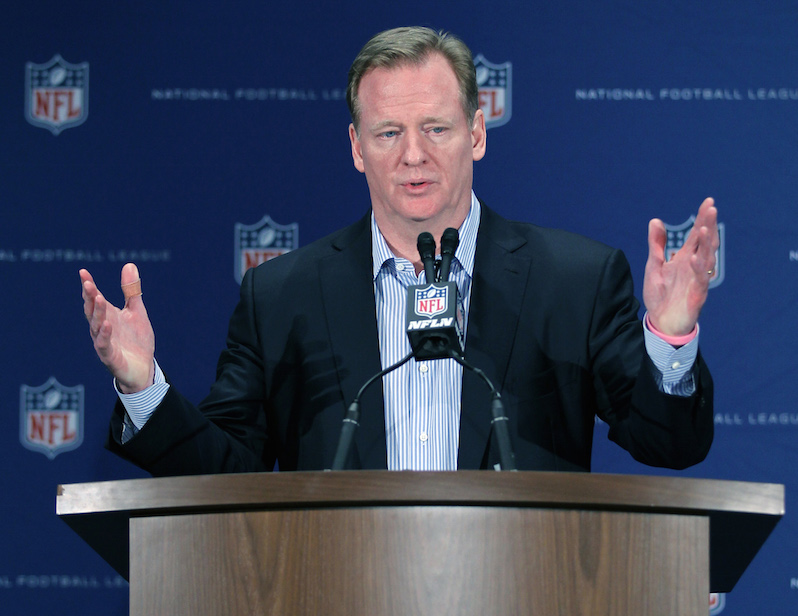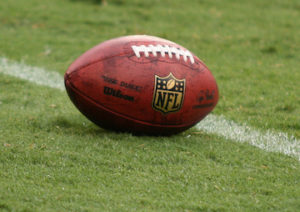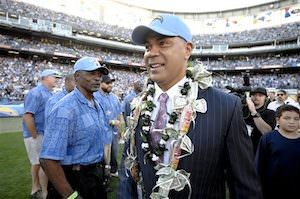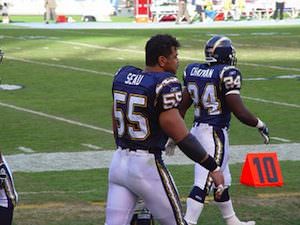NFL’s Handling of CTE Controversy Shows Compassionate Conservatism of Roger Goodell in Action
In determining the effect of concussions on the lives of football players, nobody lawyers up while making sincere protestations of loving the other side like the NFL commissioner. Roger Goodell has been the NFL commissioner since 2008. (Luis M. Alvarez / AP)
1
2
Roger Goodell has been the NFL commissioner since 2008. (Luis M. Alvarez / AP)
1
2
If the settlement ends this chapter in NFL history, the timeline, via Frontline, reads like the cigarette manufacturers’ decades-long campaign to deny their product’s health risks.
December 1994: Tagliabue creates the Mild Traumatic Brain Injury (MTBI) committee. The very word “Mild” shows the league doesn’t think it’s a big problem. Tagliabue bristles at critics questioning injuries, which he considers “one of these pack journalism issues, frankly. There is no increase in concussions. … The problem is a journalist issue.”
February 1995: Agent Leigh Steinberg, alarmed by concussions suffered by clients Troy Aikman and Steve Young, holds a seminar on the issue.
September 1999: Young is knocked out cold in what turns out to be his final NFL game.
September 2000: Dallas Cowboys owner Jerry Jones says Aikman shouldn’t worry about concussions, “since all data that we have so far don’t point to lasting effects.”
April 2001: Aikman retires at 34, citing concussions and back problems.
September 2002: Webster dies at 50. The Pittsburgh Post-Gazette reports the Hall of Famer center was “homeless, unemployed, deep in debt, beset with medical ailments, lacking health insurance, in the midst of divorce, in the care of a psychiatrist and on medication.” Omalu, of the Allegheny County coroner’s office, examines Webster’s brain and diagnoses the illness that becomes known as CTE.
June 2005: Former Pittsburgh Steeler Terry Long commits suicide at age 45 by drinking antifreeze. Omalu later examines his brain, finds CTE.
July 2005: Omalu publishes his findings about Webster’s brain in Neurosurgery, a medical journal.
May 2006: Members of the NFL’s MTBI committee call for Neurosurgery to retract Omalu’s article.
November 2006: Neurosurgery not only doesn’t retract Omalu’s article, it publishes a second paper by him on Terry Long’s brain.
February 2007: Former New England Patriots linebacker Ted Johnson tells The New York Times he “suffers from memory loss, an addiction to amphetamines and agoraphobia” after sustaining two concussions within a week in 2002. Johnson says coach Bill Belichick sent him back on the field four days after the first one, against the advice of the trainer.
June 2007: Signaling a change in NFL messaging, Goodell, now commissioner, convenes the Concussion Summit. Omalu isn’t invited. His associate, Dr. Julian Bailes, a former Steelers team doctor, speaks but says MBTI committee members dismiss his research. Goodell praises the work of the MBTI committee, noting, “One thing that troubles me sometimes, when I see media reports, is that this is something that, all of a sudden, we’ve started to focus on. We’ve had this committee for 14 years. We have done terrific work.”
September 2009: Obtaining an NFL-funded study, The New York Times reports that former players are 19 times more likely to get dementia, Alzheimer’s or other memory-related diseases. NFL spokesman Greg Aiello responds, “Memory disorders affect many people who never played football or other sports. We are trying to understand it as it relates to our retired players.”
December 2009: Aiello tells the Times, “It’s quite obvious from the medical research that’s been done that concussions can lead to long-term problems.” It’s the first time the NFL has conceded that “concussions had long-term effects.”
December 2009: The NFL tightens return-to-play guidelines, stating that players who exhibit symptoms of a concussion should not return in that game.
February 2011: Former Chicago Bears safety
Dave Duerson commits suicide, shooting himself in the chest. He leaves a note asking that his brain be studied. He is found to have had CTE.
August 2011: Former Atlanta Falcons safety Ray Easterling sues the NFL. His suit will be joined with those of 5,000 other players.
April 2012: Easterling commits suicide by shooting himself at age 62. He is found to have had CTE.
May 2012: Former San Diego Chargers and New England Patriots linebacker Junior Seau commits suicide, shooting himself in the chest at age 43. He is found to have had CTE.
January 2013: The NFL Players Association, another latecomer to this party, funds a $100 million Harvard Medical School research initiative into players’ health problems.
August 2013: The NFL announces rules changes, including a ban on hitting with the crown of the helmet. An independent neurologist will now be on the sidelines to evaluate players after blows to the head.
August 2013: In a surprise move, the NFL agrees to a $765 million settlement with the 5,000 players who brought suit. The figure will be revised upward to almost $1 billion before Judge Brody accepts it in 2015.
March 14, 2016: Under questioning by U.S. Rep. Janice Schakowsky, D-Ill., the NFL’s Jeff Miller concedes there is “certainly” a link between football, concussions and brain injuries.
March 23, 2016: Goodell says Miller’s statement is “consistent with our position over the years.”
Actually, the NFL has lots of positions.
Dallas Cowboys owner Jerry Jones says it’s “absurd” to think there’s a link between football and degenerative brain disease.
Indianapolis Colts owner Robert Irsay compares the risk in playing NFL football with taking an aspirin: “You take an aspirin, I take an aspirin, it might give you extreme side effects of illness and your body … may reject it where I would be fine. So there is so much we don’t know.”
March 24, 2016: The New York Times obtains confidential data showing that the NFL left more than 100 cases of concussion out of its research, enabling its committee to play down the problem.
In a bombshell, committee member Dr. Joseph Waeckerle tells the Times, “If somebody made a human error or somebody assumed the data was absolutely correct and didn’t question it, well, we screwed up. If we found it wasn’t accurate and still used it, that’s not a screw-up; that’s a lie.”
The story also probes connections between the NFL and tobacco manufacturers under the headline: “N.F.L.’S Flawed Concussions Research and Ties to Tobacco Industry.”
March 29, 2016 Incensed by what it calls “the Big Tobacco smear,” the NFL demands a retraction, calling the Times’ story “false and defamatory,” language that often precedes a lawsuit.
The Times stands by its story.
April 18, 2016: The appeals court affirms the NFL’s settlement with 5,000 players who filed suit.
This isn’t black and white, good versus evil. It’s true, as the NFL keeps asserting, that research is in its embryonic stages.
Different studies have different results. NFL players have been shown to lead longer, healthier lives in some studies, such as that by the National Institute for Occupational Safety and Health on behalf of the NFL Players Association.
I can’t imagine Goodell knowing all that is known and not caring.
I can imagine him surrounded by people who tell him what he wants to hear so everyone in their privileged world can go on believing what they want to believe: that they remain a boon to mankind.
Your support matters…
SUPPORT TRUTHDIG
Independent journalism is under threat and overshadowed by heavily funded mainstream media.
You can help level the playing field. Become a member.
Your tax-deductible contribution keeps us digging beneath the headlines to give you thought-provoking, investigative reporting and analysis that unearths what's really happening- without compromise.
Give today to support our courageous, independent journalists.



You need to be a supporter to comment.
There are currently no responses to this article.
Be the first to respond.